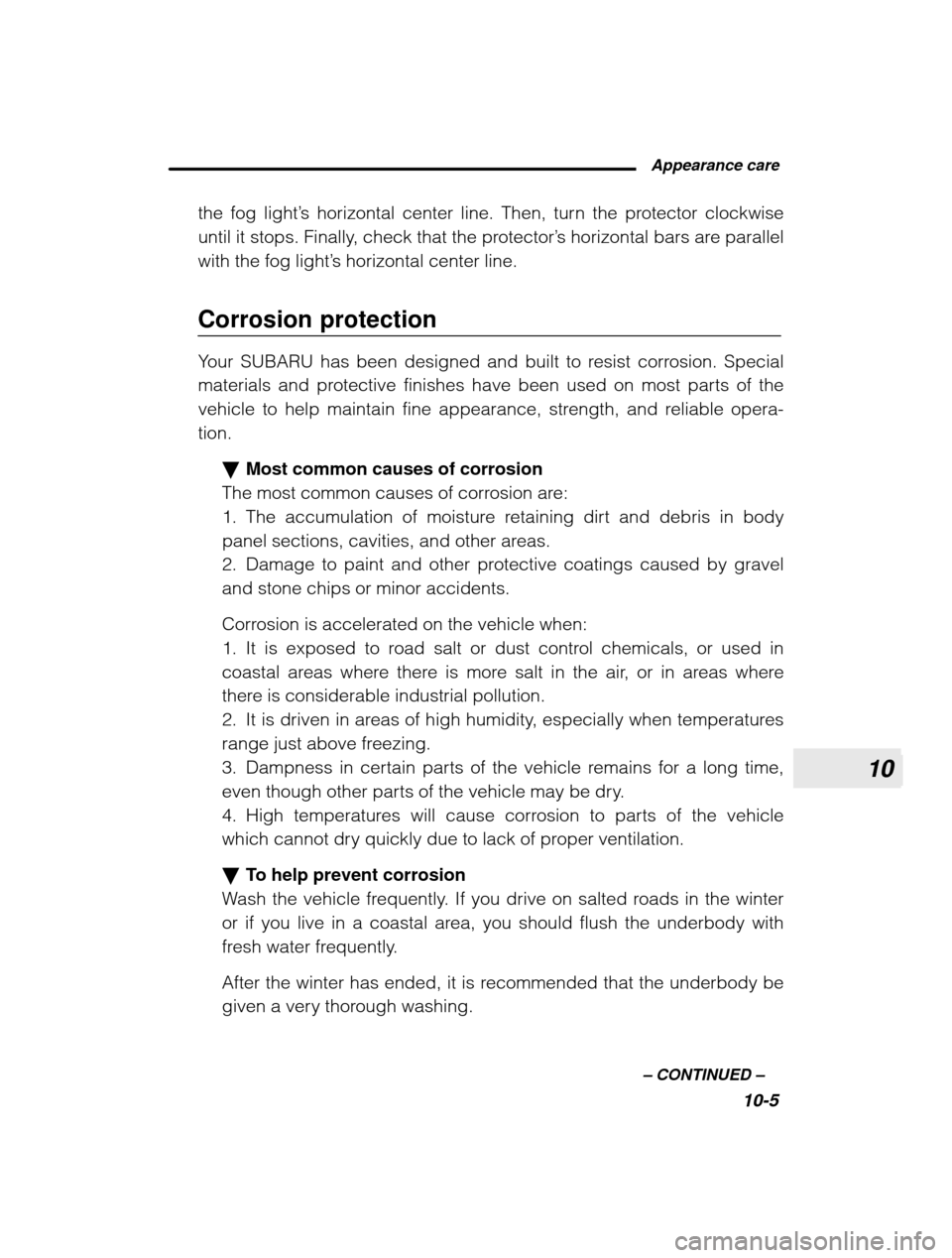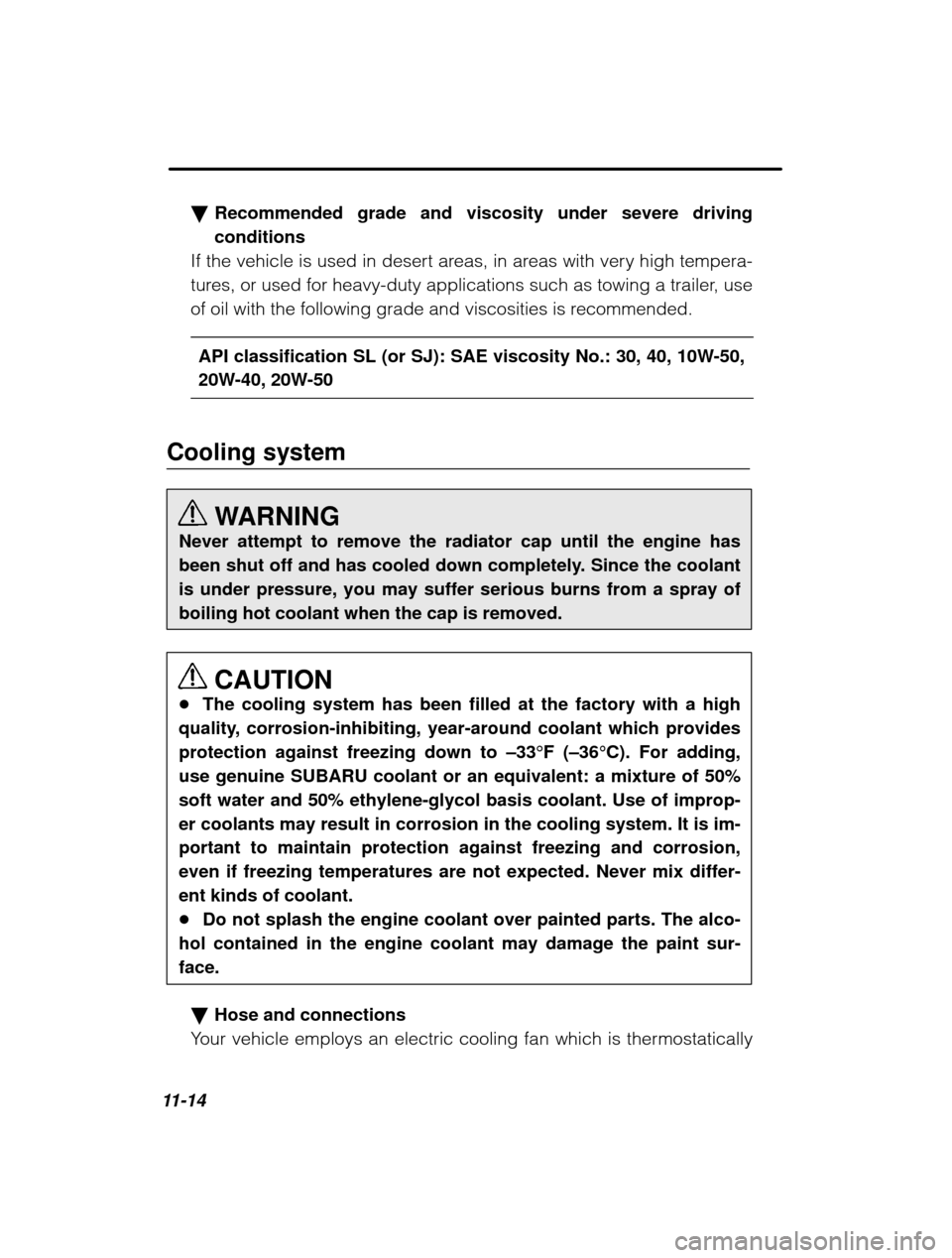Page 311 of 472

8
Driving tips8-13
–
CONTINUED –
n
Wiper operation when snowing
Before driving in cold weather, make sure the wiper blades are not
frozen to the windshield or rear window. If the wiper blades are frozen
to the windshield or rear window, use the defroster with the airflow
control button/dial in the “
” position and the temperature control
dial set for maximum warmth until the wiper blades are completely
thawed out. If your vehicle is equipped with a wiper deicer, it is helpful
to thaw the windshield wiper blades. To thaw out the rear wiper blade,
use the rear window defogger.
When driving in snow, if frozen snow starts to stick on the surface of
the windshield despite wiper operation, use the defroster with the air-
flow control button/dial in “
” and the temperature control dial set
for maximum warmth. After the windshield gets warmed enough to
melt the frozen snow on it, wash it away using the windshield washer.
Snow stuck on the wiper arm prevents the wiper from working effec-
tively. If snow is stuck on the wiper arm, pull off the road to a safe
place, then remove it. If you stop the car at road side, use the hazard
warning flasher to alert other drivers.
We recommend use of non-freezing type wiper blades (winter blades)
during the seasons you could have snow and sub-zero temperatures.
Blades of this type give superior wiping performance in snowy condi-
tions. Be sure to use blades that are suitable for your vehicle. � Corrosion protection
Refer to the “Corrosion protection ” section (chapter 10).
Page 326 of 472

8-28Trailer towing
Your car is designed and intended to be used primarily as a passenger-
carrying vehicle. Towing a trailer puts additional loads on your car
’s en-
gine, drivetrain, brakes, tires and suspension and has an adverse effect
on fuel economy.
If you do decide to tow a trailer, your safety and satisfaction depend
upon proper use of correct equipment and cautious operation of your ve-
hicle. Seek the advice of your SUBARU dealer to assist you in purchas-
ing a hitch and other necessary towing equipment appropriate for your
vehicle. In addition, be sure to follow the instructions on correct installa-
tion and use provided by the trailer and other towing equipment
manufacturers.
SUBARU assumes no responsibility for injuries or vehicle damage that
result from trailer towing equipment, or from any errors or omissions in
the instructions accompanying such equipment or for your failure to fol-
low the proper instructions.
�Warranties and maintenance
SUBARU warranties do not apply to vehicle damage or malfunction
caused by trailer towing. If you use your vehicle to tow a trailer, more
frequent maintenance will be required due to the additional load.(Refer to “Maintenance schedule under severe driving conditions ” in
the “Warranty and Maintenance Booklet ”.)
Under no circumstances should a trailer be towed with a new vehicle
or a vehicle with any new powertrain component (engine, transmis-
sion, differential, wheel bearings, etc.) for the first 1,000 miles (1,600km) of driving. � Maximum load limits
WARNING
Never exceed the maximum load limits explained below. Exceed- ing the maximum load limits could cause personal injury and/or
vehicle damage.
Page 329 of 472

8
Driving tips8-31
–
CONTINUED –
�
Gross Axle Weight (GAW) and Gross Axle Weight Rating
(GAWR)
The total weight applied to each axle (GAW) must never exceed the
Gross Axle Weight Rating (GAWR). The front and rear GAWs can be
adjusted by relocating passengers and luggage inside the vehicle.
The front and rear GAWR are also shown on the certification label.
HBF019BB
Gross Axle Weight
OM-H2784
To check both GVWR and GAWR and to confirm that the total weight
and weight distribution are within safe driving limits, you should have
your vehicle and trailer weighed at a commercial weighing station.
Be sure that all cargo is firmly secured to prevent a change in weight
distribution while driving. nTongue load
WARNING
If the trailer is loaded with more weight in the back of trailer ’s
axle than in the front, the load is taken off the rear axle of the tow- ing vehicle. This may cause the rear wheels to skid, especiallyduring braking or when vehicle speed is reduced during corner-
ing, resulting in over-steer, spin out and/or jackknifing.
Ensure that the trailer tongue load is from 8 to 11 percent of the total
trailer weight and does not exceed the maximum value of 200 lbs (90kg).
The tongue load can be weighed with a bathroom scale as shown in
Page 366 of 472

10-2Exterior care �
Washing
CAUTION
� When washing the vehicle, the brakes may get wet. As a result,
the brake stopping distance will be longer. To dry the brakes, drive the vehicle at a safe speed while lightly pressing the brakepedal to heat up the brakes.� Do not wash the engine compartment and areas adjacent to it.
If water enters the engine air intake, electrical parts or the power
steering fluid reservoir, it will cause engine trouble or faulty
power steering respectively.
The best way to preserve your vehicle ’s beauty is frequent washing.
Wash the vehicle at least once a month to avoid contamination by roadgrime.
Wash dirt off with a wet sponge and plenty of lukewarm or cold water. Do
not wash the vehicle with hot water and in direct sunlight.
Salt, chemicals, insects, tar, soot and bird droppings should be washed
off by using a light detergent, as required. If you use a light detergent,
make certain that it is a neutral detergent. Do not use strong soap or
chemical detergents. All cleaning agents should be promptly flushed
from the surface and not allowed to dry there. Rinse the vehicle thor-
oughly with plenty of lukewarm water. Wipe the remaining water off with a
chamois or soft cloth. NOTE When having your vehicle washed in an automatic car wash, make
sure beforehand that the car wash is of suitable type. If the vehicle
is equipped with a rear/roof spoiler, it may be damaged by car washbrushes or other equipment.
Page 369 of 472

10
Appearance care10-5
–
CONTINUED –
the fog light
’s horizontal center line. Then, turn the protector clockwise
until it stops. Finally, check that the protector ’s horizontal bars are parallel
with the fog light ’s horizontal center line.
Corrosion protection
Your SUBARU has been designed and built to resist corrosion. Special
materials and protective finishes have been used on most parts of the
vehicle to help maintain fine appearance, strength, and reliable opera-tion. �Most common causes of corrosion
The most common causes of corrosion are:
1. The accumulation of moisture retaining dirt and debris in body
panel sections, cavities, and other areas.
2. Damage to paint and other protective coatings caused by graveland stone chips or minor accidents.
Corrosion is accelerated on the vehicle when:
1. It is exposed to road salt or dust control chemicals, or used in
coastal areas where there is more salt in the air, or in areas where
there is considerable industrial pollution.
2. It is driven in areas of high humidity, especially when temperatures
range just above freezing.
3. Dampness in certain parts of the vehicle remains for a long time,
even though other parts of the vehicle may be dry.
4. High temperatures will cause corrosion to parts of the vehicle
which cannot dry quickly due to lack of proper ventilation. � To help prevent corrosion
Wash the vehicle frequently. If you drive on salted roads in the winter
or if you live in a coastal area, you should flush the underbody with
fresh water frequently.
After the winter has ended, it is recommended that the underbody be
given a very thorough washing.
Page 386 of 472

11-14�
Recommended grade and viscosity under severe driving conditions
If the vehicle is used in desert areas, in areas with very high tempera-
tures, or used for heavy-duty applications such as towing a trailer, use
of oil with the following grade and viscosities is recommended.
API classification SL (or SJ): SAE viscosity No.: 30, 40, 10W-50,
20W-40, 20W-50
Cooling system
WARNING
Never attempt to remove the radiator cap until the engine has
been shut off and has cooled down completely. Since the coolantis under pressure, you may suffer serious burns from a spray ofboiling hot coolant when the cap is removed.
CAUTION
� The cooling system has been filled at the factory with a high
quality, corrosion-inhibiting, year-around coolant which providesprotection against freezing down to –33�F ( –36 �C). For adding,
use genuine SUBARU coolant or an equivalent: a mixture of 50%
soft water and 50% ethylene-glycol basis coolant. Use of improp-er coolants may result in corrosion in the cooling system. It is im-portant to maintain protection against freezing and corrosion,even if freezing temperatures are not expected. Never mix differ-ent kinds of coolant.� Do not splash the engine coolant over painted parts. The alco-
hol contained in the engine coolant may damage the paint sur-face.
� Hose and connections
Your vehicle employs an electric cooling fan which is thermostatically
Page 408 of 472
11-36Replacement of brake pad and lining
CAUTION
If you continue to drive despite the scraping noise from the audi-
ble brake pad wear indicator, it will result in the need for costlybrake rotor repair or replacement.
OM-H0163
The front disc brakes and the right rear disc brake have an audible wear
indicators on the brake pads. If the brake pads wear close to their ser-
vice limit, the wear indicator makes a very audible scraping noise whenthe brake pedal is applied.
If you hear this scraping noise each time you apply the brake pedal, have the brake pads serviced by your SUBARU dealer as soon as pos-sible.
�Breaking-in of new brake pads and linings
When replacing the brake pad or lining, use only genuine SUBARU
parts. After replacement, the new parts must be broken in as follows: n Brake pad and lining
While maintaining a speed of 30 to 40 mph (50 to 65 km/h), step on
the brake pedal lightly. Repeat this five or more times.
Page 413 of 472
11
Maintenance and service11-41
–
CONTINUED –
�
Correct tire pressure (tread worn evenly)
HGB033AA
Roadholding is good, and steering is responsive. Rolling resistance is
low, so fuel consumption is also lower.
� Abnormally low tire pressure (tread worn at shoulders)
HSB012AA
Rolling resistance is high, so fuel consumption is also higher.